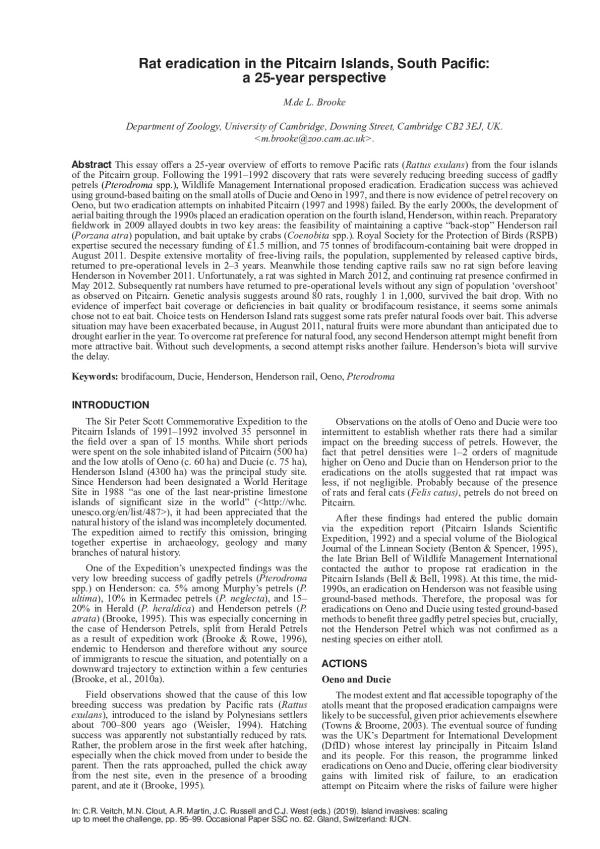Localisation
SPREP LIBRARY
Éditeur
International Union for Nature Conservation (IUCN)
Année de publication:
2019
Lieu de publication
Gland, Switzerland
Description physique:
5 p.
Numéro d'appel
[EL]
Pays concernés
Pacific Region
Langue
English
Identifiant de dossier:
650
Ancien numéro d'identification PEIN:
82529
Notes générales
Available online
Disponible en ligne
Rubrique(s) thématique(s)
Invasive species
Résumé
This essay offers a 25-year overview of efforts to remove Pacific rats (Rattus exulans) from the four islands of the Pitcairn group. Following the 1991–1992 discovery that rats were severely reducing breeding success of gadfly petrels (Pterodroma spp.), Wildlife Management International proposed eradication. Eradication success was achieved using ground-based baiting on the small atolls of Ducie and Oeno in 1997, and there is now evidence of petrel recovery on Oeno, but two eradication attempts on inhabited Pitcairn (1997 and 1998) failed. By the early 2000s, the development of aerial baiting through the 1990s placed an eradication operation on the fourth island, Henderson, within reach. Preparatory fieldwork in 2009 allayed doubts in two key areas: the feasibility of maintaining a captive “back-stop” Henderson rail (Porzana atra) population, and bait uptake by crabs (Coenobita spp.). Royal Society for the Protection of Birds (RSPB) expertise secured the necessary funding of £1.5 million, and 75 tonnes of brodifacoum-containing bait were dropped in August 2011. Despite extensive mortality of free-living rails, the population, supplemented by released captive birds, returned to pre-operational levels in 2–3 years. Meanwhile those tending captive rails saw no rat sign before leaving Henderson in November 2011. Unfortunately, a rat was sighted in March 2012, and continuing rat presence confirmed in May 2012. Subsequently rat numbers have returned to pre-operational levels without any sign of population ‘overshoot’ as observed on Pitcairn. Genetic analysis suggests around 80 rats, roughly 1 in 1,000, survived the bait drop. With no evidence of imperfect bait coverage or deficiencies in bait quality or brodifacoum resistance, it seems some animals chose not to eat bait. Choice tests on Henderson Island rats suggest some rats prefer natural foods over bait. This adverse situation may have been exacerbated because, in August 2011, natural fruits were more abundant than anticipated due to drought earlier in the year. To overcome rat preference for natural food, any second Henderson attempt might benefit from more attractive bait. Without such developments, a second attempt risks another failure. Henderson’s biota will survive the delay.
Programme(s):
Localisation
SPREP LIBRARY
Éditeur
International Union for Nature Conservation (IUCN)
Année de publication:
2019
Lieu de publication
Gland, Switzerland
Description physique:
5 p.
Numéro d'appel
[EL]
Pays concernés
Pacific Region
Langue
English
Identifiant de dossier:
650
Ancien numéro d'identification PEIN:
82529
Notes générales
Available online
Dossier créé: 31-May-2019
Dossier modifié: 16-Feb-2022

